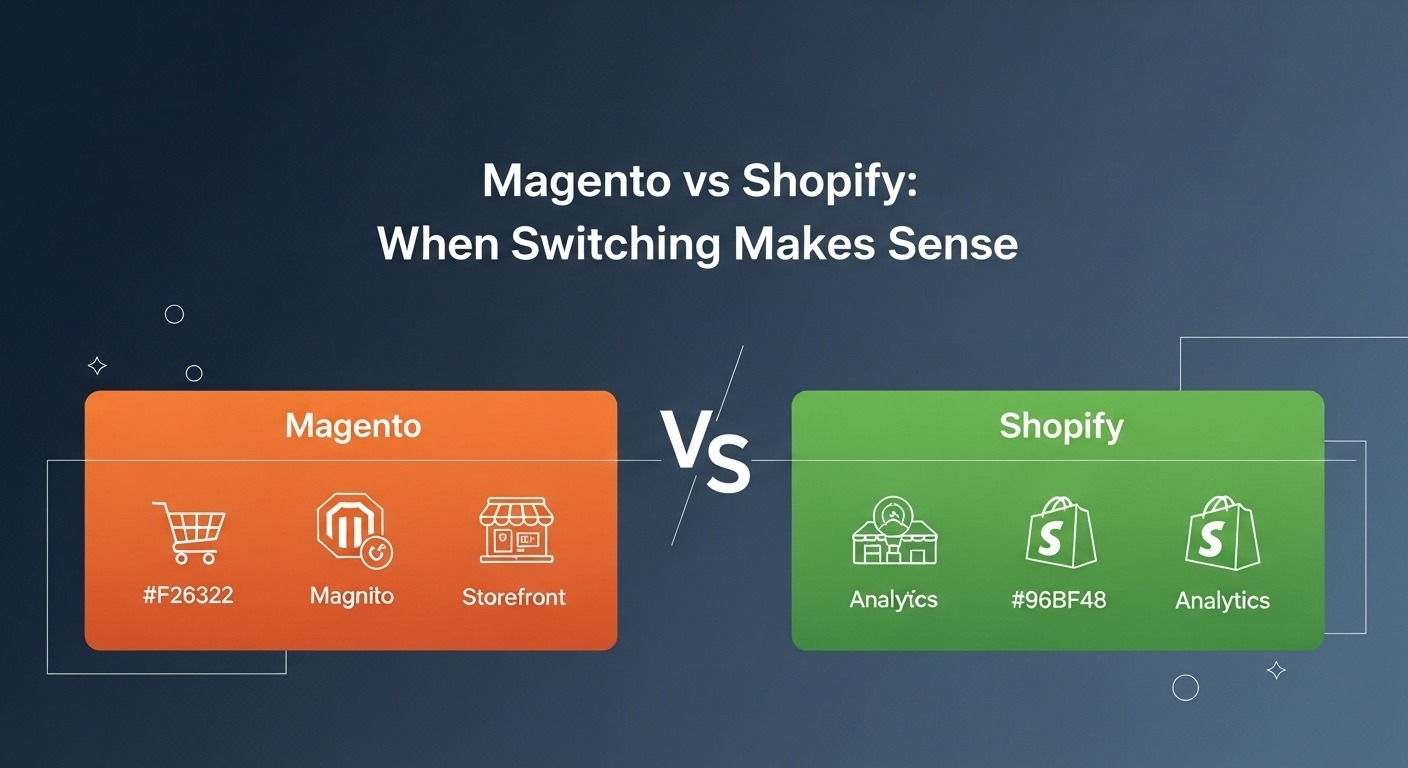Shopify vs Magento both are top eCommerce platforms, each suited to different business needs. Shopify is best for small to medium businesses seeking ease, quick setup, and built-in tools. Magento fits large enterprises needing full customization and advanced features. Switching to Magento makes sense when Shopify’s limits are reached, while moving to Shopify helps cut maintenance and simplify operations. The choice boils down to prioritizing control and flexibility (Magento) or convenience and efficiency (Shopify).
Choosing the right eCommerce platform is one of the most critical decisions for any online business. Two of the most popular options— Shopify vs Magento—serve different business needs. But when should a business consider switching from one to the other? In this post, we’ll break down real-world scenarios and problems that can guide your decision, all while keeping SEO implications in mind.
Understanding Shopify Vs Magento
Magento is an open-source eCommerce platform known for its flexibility and scalability. It’s ideal for businesses with complex catalogs, multiple integrations, and custom functionality needs. However, it often requires technical expertise or dedicated developers.
Shopify, on the other hand, is a fully hosted, user-friendly platform that allows businesses to get online quickly. While it’s easier to manage and maintain, it may lack the customization power that Magento offers for large, enterprise-level stores.
When Switching from Magento to Shopify Makes Sense
- High Maintenance Costs
- Problem: Magento requires frequent updates, server maintenance, and often a development team to manage technical issues.
- Real-world example: Small businesses spending thousands annually on developers to maintain extensions and security patches.
- SEO Impact: Slow updates and server issues can affect page load speed and security, leading to lower search rankings.
- Need for Simplicity and Speed
- Problem: Magento’s backend can be overwhelming for non-technical users.
- Real-world example: Businesses struggling with updating product pages, creating landing pages, or managing promotions due to complex workflows.
- SEO Impact: Difficulty updating on-page content or meta tags can negatively affect keyword optimization and organic traffic.
- Limited Budget for IT Infrastructure
- Problem: Magento often requires dedicated hosting and additional resources.
- Real-world example: Small-to-medium businesses looking to cut costs without sacrificing functionality.
- SEO Impact: Shopify’s optimized hosting can improve site speed—a key ranking factor—without the need for costly infrastructure.
- Desire for Built-in Marketing Tools
- Problem: Magento lacks some out-of-the-box marketing tools; you often need third-party plugins.
- Real-world example: Businesses want integrated email campaigns, loyalty programs, and abandoned cart recovery.
- SEO Impact: Easy integration with marketing tools on Shopify can improve user engagement signals, indirectly boosting SEO performance.
When Switching from Shopify to Magento Makes Sense

- High Product Volume and Complex Catalogs
- Problem: Shopify can struggle with thousands of SKUs or complex product variations.
- Real-world example: Fashion or electronics stores needing multi-level categories, configurable products, and advanced filters.
- SEO Impact: Magento allows deeper category hierarchies and better structured URLs, enhancing indexation and keyword targeting.
- Custom Functionality Requirements
- Problem: Shopify has limitations on backend customizations and integrations.
- Real-world example: Businesses needing complex pricing rules, custom shipping calculations, or third-party ERP integrations.
- SEO Impact: Magento’s flexibility allows better technical SEO implementation, such as structured data, canonical tags, and custom URL redirects.
- Multi-store and Multi-language Needs
- Problem: Shopify handles multiple stores or languages with apps, which can be costly and less efficient.
- Real-world example: Global brands looking to manage several storefronts from one backend.
- SEO Impact: Magento’s multi-store setup ensures better hreflang implementation, avoiding duplicate content issues and improving international SEO.
- Advanced SEO Customization
- Problem: Shopify has limitations on URL structures, meta-data management, and schema markup.
- Real-world example: Businesses focused on content-rich SEO strategies or local SEO for multiple regions.
- SEO Impact: Magento provides complete control over technical SEO, which can significantly improve organic rankings in competitive markets.
Key Considerations Before Switching
- Data Migration: Moving products, customer data, and URLs must be handled carefully to avoid losing SEO equity.
- 301 Redirects: Maintain all existing URLs or implement proper redirects to preserve rankings.
- Site Speed and Performance: Ensure the new platform is optimized for fast loading times.
- SEO Audit: Perform a pre- and post-migration SEO audit to identify issues and track improvements.
Conclusion
Switching between Shopify vs Magento is not just a technical decision—it’s strategic. Businesses should evaluate factors such as budget, product complexity, team expertise, marketing needs, and SEO requirements.
- Switch to Shopify if you want simplicity, faster time-to-market, lower maintenance costs, and better out-of-the-box marketing tools.
- Switch to Magento if you require advanced customization, high-volume catalogs, multi-store capabilities, or deep SEO control.
Making the right choice ensures not only operational efficiency but also maximizes your potential for organic growth and online visibility.

